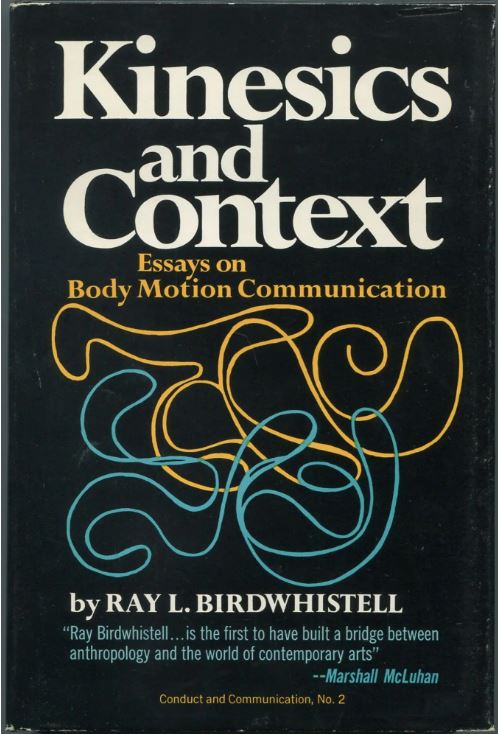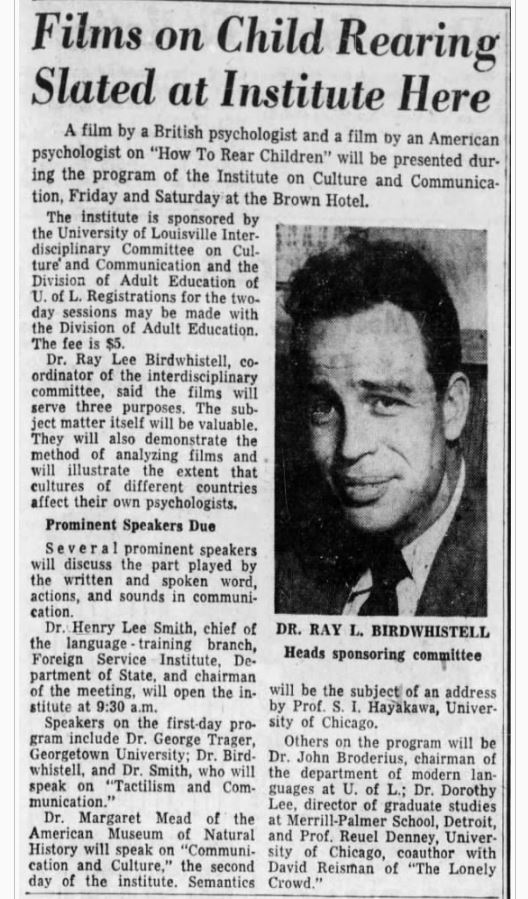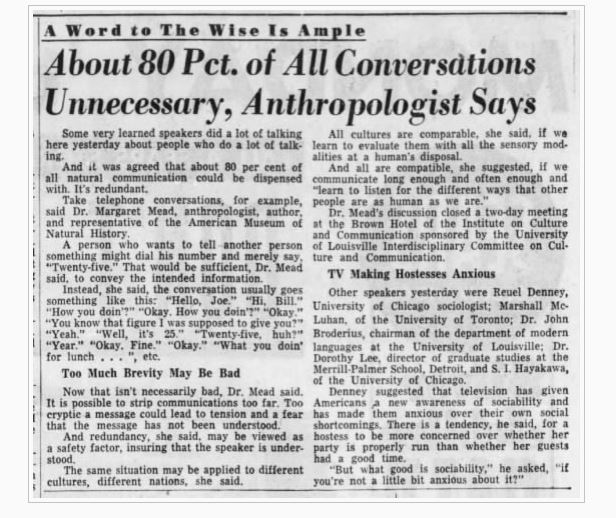McLuhan and S.I. Hayakawa were on the program together at a conference at the University of Louisville in October 1954. Both spoke on its first day. When they met there, how many meetings with other and commonalities of interest they able to recount to each other since the time, almost thirty years before, when they were students and neighbors in Winnipeg? Had they met in Madison in the mid-1930s when they both worked there?1 Did their separate associations with Sigfried Giedion in the 1940s bring them together personally at all?2
The introductory notes to the reprint of Explorations 3 include this information:
In November [should be October] 1954, the Explorations researchers attended the “Institute on Culture and Communication” organised by Ray Birdwhistell3 at the University of Louisville‘s Interdisciplinary Committee on Culture and Communication. A number of the contributions to Explorations 3 are essays or early drafts of contributions related to this conference (Birdwhistell, Lee, Trager & Hall).
On October 17, 1954, the Louisville Courier-Journal announced the event as follows:
Films on Child Rearing Slated at Institute Here
A film by a British psychologist and a film by an American psychologist on “How To Rear Children” will be presented during the program of the Institute on Culture and Communication, Friday [Oct 22, 1954] and Saturday [Oct 23, 1954] at the Brown Hotel. The Institute is sponsored by the University of Louisville Interdisciplinary Committee on Culture’ and Communication and the Division of Adult Education of U. of L. Registrations for the two-day sessions may be made with the Division of Adult Education. The fee is $5.
Dr. Ray Lee Birdwhistell, coordinator of the interdisciplinary committee, said the films will serve three purposes. The subject matter itself will be valuable. They will also demonstrate the method of analyzing films and will illustrate the extent that cultures of different countries affect their own psychologists.
Prominent Speakers Due
Several prominent speakers will discuss the part played by the written and spoken word, actions, and sounds in communication. Dr. Henry Lee Smith, chief of the language-training branch, Foreign Service Institute, Department of State, and chairman of the meeting, will open the institute at 9:30 a.m. Speakers on the first-day program include Dr. George Trager, Georgetown University; Dr. Birdwhistell, and Dr. Smith, who will speak on “Tactilism and Communication”.4 Dr. Margaret Mead of the American Museum of Natural History will speak on “Communication and Culture,” the second day of the institute. Semantics will be the subject of an address by Prof. S. I. Hayakawa, University of Chicago. Others on the program will be Dr. John Broderius, chairman of the department of modern languages at U. of L.; Dr. Dorothy Lee, director of graduate studies at Merrill-Palmer School, Detroit, and Prof. Reuel Denney, University of Chicago, coauthor with David Reisman of The Lonely Crowd.
After the event, the Courier-Journal reported it as follows:
About 80% of All Conversations Unnecessary, Anthropologist Says
Some very learned speakers did here yesterday about people who do a lot of talking. And it was agreed that about 80 per cent of all natural communication could be dispensed with. It’s redundant. Take telephone conversations, for example, said Dr. Margaret Mead, anthropologist, author, and representative of the American Museum of Natural History. A person who wants to tell another person something might dial his number and merely say, “Twenty-five.” That would be sufficient, Dr. Mead said, to convey the intended information. Instead, she said, the conversation usually goes something like this: “Hello, Joe.” “Hi, Bill.” “How you doin’?” “Okay. How you doin’?” “Okay.” “You know that figure I was supposed to give you?” “Yeah.” “Well, it’s 25.” “Twenty-five, huh?” “Year.” “Okay. Fine.” “Okay.” “What you doin for lunch . . . “, etc.
Too Much Brevity May Be Bad
Now that isn’t necessarily bad, Dr. Mead said. It is possible to strip communications too far. Too cryptic a message could lead to tension and a fear that the message has not been understood. And redundancy, she said, may be viewed as a safety factor, insuring that the speaker is understood. The same situation may be applied to different cultures, different nations, she said.
All cultures are comparable, she said, if we learn to evaluate them with all the sensory modalities at a human’s disposal. And all are compatible, she suggested, if we communicate long enough and often enough and “learn to listen for the different ways that other people are as human as we are.”
Dr. Mead’s discussion closed a two-day meeting at the Brown Hotel of the Institute on Culture and Communication sponsored by the University of Louisville Interdisciplinary Committee on Culture and Communication.
TV Making Hostesses Anxious
Other speakers yesterday were Reuel Denney, University of Chicago sociologist; Marshall McLuhan, of the University of Toronto; Dr. John Broderius, chairman of the department of modern languages at the University of Louisville; Dr. Dorothy Lee, director of graduate studies at the Merrill-Palmer School, Detroit, and S. I. Hayakawa, of the University of Chicago. Denney suggested that television has given Americans a new awareness of sociability and has made them anxious over their own social shortcomings. There is a tendency, he said, for a hostess to be more concerned over whether her party is properly run than whether her guests had a good time. “But what good is sociability,” he asked, “if you’re not a little bit anxious about it?”
- McLuhan was a teaching assistant in the English Department at UW Madison in 1936-1937. See Lloyd Wheeler. Hayakawa, after obtaining his PhD in English at UW in 1935, began his fulltime teaching career there from 1936 to 1939. Hayakawa, too, had been a teaching assistant in Madison from 1930 to 1935, but in 1936 he was promoted to instructor. During McLuhan’s tenure in Madison, however, Hayakawa may have been away from Madison the whole time. They may not have met in person there. But, as described in a talk McLuhan gave in New York in a panel discussion with Hayakawa in 1966, he certainly heard of Hayakawa then. ↩
- See Hayakawa — The Revision of Vision and Moholy-Nagy 2 (Hayakawa). ↩
- Birdwhistell had been at the University of Toronto in the anthropology department in the mid 1940s and McLuhan may already have met him there. One of Birdwhistell’s students at UT was Erving Goffman, another Winnipigeon, who later became a colleague of Birdwhistell when both taught at the University of Pennsylvania. ↩
- In 1970 Birdwhistell published Kinesics and Context: Essays on Body Motion Communication as the second volume in a ‘Conduct and Communication’ series. Its front cover featured a blurb from McLuhan: “Ray Birdwhistell (…) is the first to have built a bridge between anthropology and the world of contemporary arts.” Birdwhistell’s presentation at the 1954 conference on “Tactilism and Communication” and its connection with “Kinesics” (as seen in the title of his later book) may be behind McLuhan’s characterization of ‘kinesis’ as a variety of ‘tactility’. For discussion and references, see The kinetic sense.
 ↩
↩

